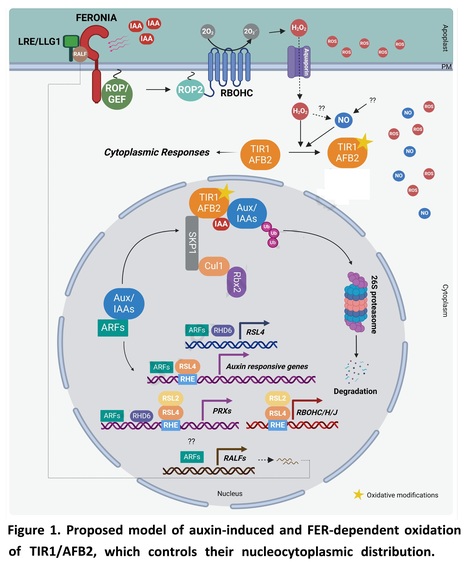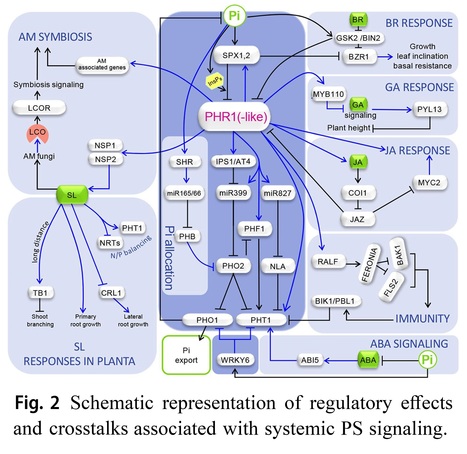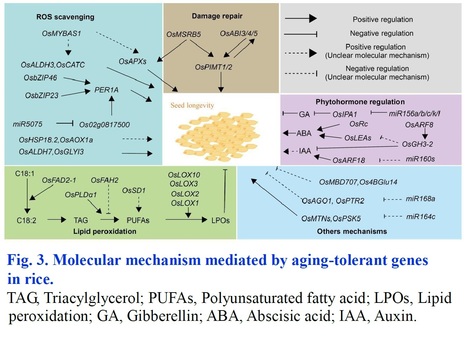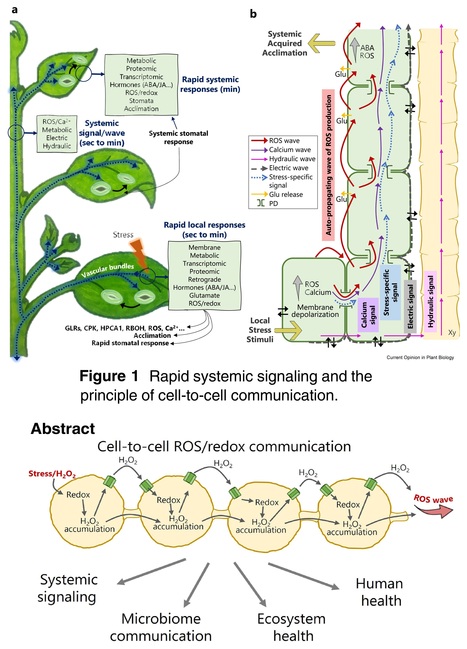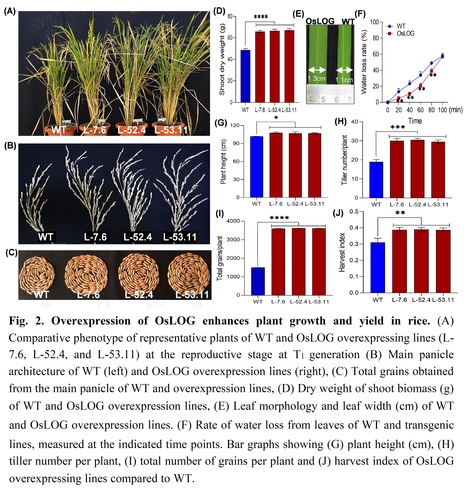 Your new post is loading...
 Your new post is loading...
Authors: Puja Ghosh and Aryadeep Roychoudhury.
Journal of Plant Growth Regulation (2024)
Abstract: "Plants are constantly exposed to a wide range of stress situations, such as biotic stressors caused by pathogenic microbes and herbivores, as well as abiotic stress factors like drought, salinity, and severe temperature. Plants have developed an intricate and sophisticated network of molecular signaling in response to various stresses that allow them to recognize and respond to challenging circumstances. Plant peptides have emerged as key participants in orchestrating biotic and abiotic stress responses, as well as taking part in signaling pathways for reactive oxygen species (ROS). ROS play a key role as secondary messengers in stress signaling and include chemicals, including superoxide, hydrogen peroxide, and singlet oxygen. This exhaustive review investigates the multiple functions of plant peptides in ROS signaling and stress responses and clarifies the interaction between plant peptide-mediated stress responses and ROS signaling. We have highlighted several plant peptide classes such as defense peptides, antimicrobial peptides and signaling peptides that contribute to the complex interaction between abiotic and biotic stress response pathways. A thorough overview of the complex regulatory network that permits plants to flourish under demanding environmental conditions is presented by synthesizing recent gains in our knowledge of the functions of plant peptides in stress responses and ROS signaling. We have also highlighted the fact that knowledge of such peptide-mediated signaling may be used for crop improvement that would increase agricultural sustainability and stress tolerance, ultimately boosting food security and environmental resilience on a global scale."
Authors: Baris Uzilday, Kaori Takahashi, Akie Kobayashi, Rengin Ozgur Uzilday, Nobuharu Fujii, Hideyuki Takahashi and Ismail Turkan.
Plants (2024)
Abstract: "Plant roots exert hydrotropism in response to moisture gradients to avoid drought stress. The regulatory mechanism underlying hydrotropism involves novel regulators such as MIZ1 and GNOM/MIZ2 as well as abscisic acid (ABA), reactive oxygen species (ROS), and Ca2+ signaling. ABA, ROS, and Ca2+ signaling are also involved in plant responses to drought stress. Although the mechanism of moisture gradient perception remains largely unknown, the sensory apparatus has been reported to reside in the root elongation zone rather than in the root cap. In Arabidopsis roots, hydrotropism is mediated by the action of MIZ1 and ABA in the cortex of the elongation zone, the accumulation of ROS at the root curvature, and the variation in the cytosolic Ca2+ concentration in the entire root tip including the root cap and stele of the elongation zone. Moreover, root exposure to moisture gradients has been proposed to cause asymmetric ABA distribution or Ca2+ signaling, leading to the induction of the hydrotropic response. A comprehensive and detailed analysis of hydrotropism regulators and their signaling network in relation to the tissues required for their function is apparently crucial for understanding the mechanisms unique to root hydrotropism. Here, referring to studies on plant responses to drought stress, we summarize the recent findings relating to the role of ABA, ROS, and Ca2+ signaling in hydrotropism, discuss their functional sites and plausible networks, and raise some questions that need to be answered in future studies."
Authors: Victoria Berdion Gabarain, Miguel A. Ibeas, Hernan Salinas-Grennet and José M. Estevez.
Molecular Plant (2024)
Excerpts: "A recent study published in Molecular Plant led by Prof. Chao Li (Lu et al. 2024) provides strong evidence that the targeting of TRANSPORT INHIBITOR RESPONSE 1 (TIR1)/AUXIN-SIGNALING F-BOX 2 (AFB2) to the nucleus is dependent on the oxidation triggered by auxin. The results of this work demonstrate that biologically active ROS, specifically hydrogen peroxide (H2O2) and nitric oxide (NO), play both a crucial role in the localization of TIR1/AFB2 proteins between the nucleus and cytoplasm in RHs (Figure 1)."
"The oxidized versions of TIR1 and AFB2 are essential for improving the effectiveness of TIR1 and AFB2 in transcriptional auxin responses in RH growth. Overall, a new mechanism is proposed by which auxin promotes the movement of TIR1/AFB2 from the cytoplasm to the nucleus and this process is controlled by the FER-ROS signaling pathway. The authors illuminate the complex interactions between auxin signaling pathways, redox signaling molecules, and protein changes that drive plant growth and development."
Authors: María Isabel Puga, César Poza-Carrión, Iris Martinez-Hevia, Laura Perez-Liens and Javier Paz-Ares
Journal of Plant Research (2024)
Abstract: "Phosphorus is indispensable for plant growth and development, with its status crucial for determining crop productivity. Plants have evolved various biochemical, morphological, and developmental responses to thrive under conditions of low P availability, as inorganic phosphate (Pi), the primary form of P uptake, is often insoluble in soils. Over the past 25 years, extensive research has focused on understanding these responses, collectively forming the Pi starvation response system. This effort has not only expanded our knowledge of strategies to cope with Pi starvation (PS) but also confirmed their adaptive significance. Moreover, it has identified and characterized numerous components of the intricate regulatory network governing P homeostasis. This review emphasizes recent advances in PS signaling, particularly highlighting the physiological importance of local PS signaling in inhibiting primary root growth and uncovering the role of TORC1 signaling in this process. Additionally, advancements in understanding shoot-root Pi allocation and a novel technique for studying Pi distribution in plants are discussed. Furthermore, emerging data on the regulation of plant-microorganism interactions by the PS regulatory system, crosstalk between the signaling pathways of phosphate starvation, phytohormones and immunity, and recent studies on natural variation in Pi homeostasis are addressed.
Authors: Muhmmad Asad Ullah Asad, Zhang Yan, Lujian Zhou, Xianyue Guan and Fangmin Cheng.
Plant Physiology and Biochemistry (2024)
Highlights: • Sugars play an essential role in the regulations of leaf senescence. • Abiotic stresses trigger sugar signaling by inducing reactive oxygen species burst. • Sugar signaling interact with plant hormones and protein kinase to regulates leaf senescence. • Abiotic stresses target sugar signaling to regulate photosynthesis inhibition and programmed cell death (PCD).
Abstract: "Plants have evolved the adaptive capacity to mitigate the negative effect of external adversities at chemical, molecular, cellular, and physiological levels. This capacity is conferred by triggering the coordinated action of internal regulatory factors, in which sugars play an essential role in the regulating chloroplast degradation and leaf senescence under various stresses. In this review, we summarize the recent findings on the senescent-associated changes in carbohydrate metabolism and its relation to chlorophyll degradation, oxidative damage, photosynthesis inhibition, programmed cell death (PCD), and sink-source relation as affected by abiotic stresses. The action of sugar signaling in regulating the initiation and progression of leaf senescence under abiotic stresses involves interactions with various plant hormones, reactive oxygen species (ROS) burst, and protein kinases. This discussion aims to elucidate the complex regulatory network and molecular mechanisms that underline sugar-induced leaf senescence in response to various abiotic stresses. The imperative role of sugar signaling in regulating plant stress responses potentially enables the production of crop plants with modified sugar metabolism. This, in turn, may facilitate the engineering of plants with improved stress responses, optimal life span and higher yield achievement."
Authors: Baiyan Lu, Shengnan Wang, Hanqian Feng, Jing Wang, Kaixing Zhang, Yilin Li, Ping Wu, Minmin Zhang, Yanshu Xia, Chao Peng and Chao Li.
Molecular Plant (2024)
Short Summary: Auxin activates the FER/LLG1–RAC/ROP pathway to stimulate ROS and NO production in root hair cells, which leads to oxidative modifications of TIR1 C140/C516/AFB2 C135/C511 and in turn their transport from the cytoplasm to nucleus, whereby regulates the auxin responsive genes’ expression.
Abstract: "The phytohormone auxin plays a pivotal role in governing plant growth and development. While the TRANSPORT INHIBITOR RESPONSE1/AUXIN SIGNALING F-BOX (TIR1/AFBs) receptors function in both the nucleus and cytoplasm, the mechanism governing the distribution of TIR1/AFBs between these small cellular compartments remains unknown. In this study, we demonstrate that auxin-mediated oxidation of TIR1/AFB2 is essential for their targeting to the nucleus. Our findings reveal that small active molecules, reactive oxygen species (ROS) and nitric oxide (NO), are indispensable for the nucleo-cytoplasmic distribution of TIR1/AFB2 in trichoblasts and root hairs. This process is regulated by the FERONIA receptor kinase–NADPH oxidase signaling pathway. ROS and NO initiate oxidative modifications in TIR1 C140/516 and AFB2 C135/511, facilitating their subsequent nuclear import. The oxidized forms of TIR1 C140/516 and AFB2 C135/511 play a crucial role in enhancing the functionality of TIR1 and AFB2 in transcriptional auxin responses. In summary, our study unveils a novel mechanism through which auxin stimulates the transportation of TIR1/AFB2 from the cytoplasm to the nucleus, orchestrated by the FERONIA–ROS signaling pathway."
Authors: Qian-Qian Liu, Jin-Qiu Xia, Jie Wu, Yi Han, Gui-Quan Zhang, Ping-Xia Zhao and Cheng-Bin Xiang.
Journal of Genetics and Genomics (2024)
Abstract: "Vascular plants have evolved intricate long-distance signaling mechanisms to cope with environmental stress, with reactive oxygen species (ROS) emerging as pivotal systemic signals in plant stress responses. However, the exact role of ROS as root-to-shoot signals in the drought response has not been determined. In this study, we reveal that compared with wild-type plants, ferric reductase defective 3 (frd3) mutants exhibit enhanced drought resistance concomitant with elevated NCED3 transcript levels and ABA contents in leaves as well as increased hydrogen peroxide (H2O2) levels in roots and leaves. Grafting experiments distinctly illustrate that drought resistance can be conferred by the frd3 rootstock regardless of the scion genotype, indicating that long-distance signals originating from frd3 roots promote an increase in ABA levels in leaves. Intriguingly, the drought resistance conferred by the frd3 mutant rootstock is weakened by the CAT2-overexpressing scion, suggesting that H2O2 may be involved in the long-distance signaling. Moreover, the results of comparative transcriptome and proteome analyses support the drought resistance phenotype of the frd3 mutant. Taken together, our findings substantiate the notion that frd3 root-derived long-distance signals trigger ABA synthesis in leaves and enhance drought resistance, providing new evidence for root-to-shoot long-distance signaling in the drought response of plants."
Authors: Ronald J. Myers, María Ángeles Peláez-Vico and Yosef Fichman.
Plant, Cell & Environment (2024)
One-sentence summary: Reactive oxygen species waves can be triggered by varying types of stress stimuli in local tissues and spread from cell to cell to induce systemic acclimation.
Abstract: "Reactive oxygen species (ROS) play a critical role in plant development and stress responses, acting as key components in rapid signalling pathways. The ‘ROS wave’ triggers essential acclimation processes, ultimately ensuring plant survival under diverse challenges. This review explores recent advances in understanding the composition and functionality of the ROS wave within plant cells. During their initiation and propagation, ROS waves interact with other rapid signalling pathways, hormones and various molecular compounds. Recent research sheds light on the intriguing lack of a rigid hierarchy governing these interactions, highlighting a complex interplay between diverse signals. Notably, ROS waves culminate in systemic acclimation, a crucial outcome for enhanced stress tolerance. This review emphasizes the versatility of ROS, which act as flexible players within a network of short- and long-term factors contributing to plant stress resilience. Unveiling the intricacies of these interactions between ROS and various signalling molecules holds immense potential for developing strategies to augment plant stress tolerance, contributing to improved agricultural practices and overall ecosystem well-being."
Authors: Vijay Pratap Singh, Saumya Jaiswal, Yuanyuan Wang, Shouli Feng, Durgesh Kumar Tripathi, Samiksha Singh, Ravi Gupta, Dawei Xue, Shengchun Xu and Zhong-Hua Chen.
Trends in Plant Science (2024)
Highlights: Reactive oxygen species (ROS) are considered toxic substances causing oxidative damage in plants, but they are also important signaling molecules crucial for many developmental processes of root and leaf. The origin of many major ROS signaling target proteins is highly conserved, predating the evolution of land plants. ROS function for the regulation of root and leaf development with the presence of phytohormones, gasotransmitters, and target proteins, particularly mitogen-activated protein kinases (MAPKs).
Abstract: "Reactive oxygen species (ROS) are the key players in regulating developmental processes of plants. Plants have evolved a large array of gene families to facilitate the ROS-regulated developmental process in roots and leaves. However, the cellular targets of ROS during plant evolutionary development are still elusive. Here, we found early evolution and large expansions of protein families such as mitogen-activated protein kinases (MAPK) in the evolutionarily important plant lineages. We review the recent advances in interactions among ROS, phytohormones, gasotransmitters, and protein kinases. We propose that these signaling molecules act in concert to maintain cellular ROS homeostasis in developmental processes of root and leaf to ensure the fine-tuning of plant growth for better adaptation to the changing climate."
Authors: Nikita Yadav, Preeti Nagar, Abhilasha Rawat and Ananda Mustafiz.
Environmental and Experimental Botany (2024)
Highlights: • Expression of PSKR is up-regulated in the senescent leaves. • Over-expressing lines of AtPSKR1 and OsPSKR10 show an early leaf senescence phenotype. • AtPSKR1 and OsPSKR10 trigger superoxides accumulation in leaves. • AtPSKR1 and OsPSKR10 interact with the NADPH oxidases (AtRBOHD and AtRBOHF).
Abstract "Leaf senescence represents an active and regulated degeneration process. Leucine-rich repeat receptor-like protein kinase (LRR-RLK) represents a large group of cell surface receptors that play important roles in multiple biological processes, and some are also known to regulate the senescence process. In the present study, we elucidated the involvement of Phytosulfokine Receptor (PSKR) gene in the regulation of leaf senescence. The expression of PSKR1 of Arabidopsis was found to be up-regulated during leaf senescence. The over-expressing lines of AtPSKR1 and its rice homologue OsPSKR10 displayed an early leaf senescent phenotype in Arabidopsis, while the late senescence in mutant line of AtPSKR1 supported the idea that PSKR positively regulate the process of leaf senescence. Furthermore, the leaves of the overexpressing lines displayed increased superoxide accumulation compared to mutant lines, along with higher expression of NADPH oxidases (AtRBOHD and AtRBOHF). Importantly, our findings demonstrates that both AtPSKR1 and OsPSKR10 interact with AtRBOHD and AtRBOHF and thereby instigating superoxide accumulation in the leaves through NADPH oxidases."
Authors: Tianshun Zhou, Dong Yu, Liubing Wu, Yusheng Xu, Meijuan Duan and Dingyang Yuan.
Rice Science (2024)
Abstract: "Long-term storage of crop seeds is critical for germplasm resource conservation, food supply and sustainable production. As a major food, rice has a huge stock for production and consumption worldwide, while easily losing food value and seed viability during storage. Thus, understanding the physiological responses and molecular mechanisms of aging tolerance lays the foundation for improving seed storability in rice. This review illustrates the current advances in influential factors, evaluation methods, and identification indexes of seed storability. It also discusses the physiological consequences, molecular mechanisms, and methods to breed aging-tolerant rice in detail. Finally, it points out some challenges in the research of seed storability that need to be addressed in the future. This review provides a theoretical basis and research direction for revealing the mechanisms underlying seed storability and breeding aging tolerant rice."
Authors: Liyu Huang, Yachong Bao, Shiwen Qin, Min Ning, Qinyan Li, Qingmao Li, Shilai Zhang, Guangfu Huang, Jing Zhang, Wensheng Wang, Binying Fu and Fengyi Hu.
The Crop Journal (2024)
Abstract: "Upland rice shows dryland adaptation in the form of a deeper and denser root system and greater drought resistance than its counterpart, irrigated rice. Our previous study revealed a difference in the frequency of the OsNCED2 gene between upland and irrigated populations. A nonsynonymous mutation (C to T, from irrigated to upland rice) may have led to functional variation fixed by artificial selection, but the exact biological function in dryland adaptation is unclear. In this study, transgenic and association analysis indicated that the domesticated fixed mutation caused functional variation in OsNCED2, increasing ABA levels, root development, and drought tolerance in upland rice under dryland conditions. OsNCED2-overexpressing rice showed increased reactive oxygen species-scavenging abilities and transcription levels of many genes functioning in stress response and development that may regulate root development and drought tolerance. OsNCED2T-NILs showed a denser root system and drought resistance, promoting the yield of rice under dryland conditions. OsNCED2T may confer dryland adaptation in upland rice and may find use in breeding dryland-adapted, water-saving rice."
Authors: Cheng Zhang, Charles Tetteh, Sheng Luo, Pinyuan Jin, Xingqian Hao, Min Sun, Nan Fang, Yingjun Liu and Huajian Zhang.
Molecular Plant Pathology (2024)
Abstract: Pectin has been extensively studied in animal immunity, and exogenous pectin as a food additive can provide protection against inflammatory bowel disease. However, the utility of pectin to improve immunity in plants is still unstudied. Here, we found exogenous application of pectin triggered stomatal closure in Arabidopsis in a dose- and time-dependent manner. Additionally, pectin activated peroxidase and nicotinamide adenine dinucleotide phosphate (NADPH) oxidase to produce reactive oxygen species (ROS), which subsequently increased cytoplasmic Ca2+ concentration ([Ca2+]cyt) and was followed by nitric oxide (NO) production, leading to stomatal closure in an abscisic acid (ABA) and salicylic acid (SA) signalling-dependent mechanism. Furthermore, pectin enhanced the disease resistance to Pseudomonas syringae pv. tomato DC3000 (Pst DC3000) with mitogen-activated protein kinases (MPKs) MPK3/6 activated and upregulated expression of defence-responsive genes in Arabidopsis. These results suggested that exogenous pectin-induced stomatal closure was associated with ROS and NO production regulated by ABA and SA signalling, contributing to defence against Pst DC3000 in Arabidopsis.
|
Authors: Akbar Ali, Krishan Kant, Navneet Kaur, Shalu Gupta, Parnika Jindal, Sarvajeet Singh Gill and M. Naeem.
South African Journal of Botany (2024)
Highlights: • Salicylic acid (SA) has encouraging effects on the growth and development of plants. • SA stimulates signalling in plants via several stress proteins and genes. • SA positively interacts with other phytohormones. • SA enhances plant tolerance towards abiotic stress.
Abstract: "Drastic change in global climatic conditions has significantly increased the frequency of abiotic stresses, such as different temperature regimes (high, low, or freezing stress), uneven precipitation leading to flooding or drought, soil salinization, cyclones and hurricanes which pose a major challenge to the crop productivity and food security. Therefore, it becomes imperative for the global science community to engineer stress tolerance in crop plants to ensure enough food for the globe. Plant growth regulators play an important function in stress management. One putative plant hormone that aids plants in coping with biotic and abiotic stressors is salicylic acid (SA). SA also cooperates with other phytohormones, such as gibberellins, auxins, abscisic acid, jasmonic acid, ethylene, polyamines, nitric oxide, and to counter the negative effects of environmental perturbations. Moreover, SA shields plants from oxidative stress by reducing the production of reactive oxygen species in challenging circumstances. Additionally, SA stimulates gas exchange, photosynthesis, and osmolyte synthesis in plants, which counteract the damage caused by ROS. Exogenous application of SA to agricultural crops including medicinal and aromatic plants improves their abiotic stress tolerance, either individually or in combination with other phytohormones. SA can stimulate the production of secondary metabolites by controlling the expression of stress-related genes, activating or regulating several key enzymes, and balancing the ion content. The present review summarizes the various mechanisms by which SA confers abiotic stress tolerance in plants through homeostasis, signalling, and crosstalk with other phytohormones."
Authors: Ping Yun, Cengiz Kaya and Sergey Shabala.
The Crop Journal (2024)
Abstract: "Salinity stress is a major environmental stress affecting crop productivity, and its negative impact on global food security is only going to increase, due to current climate trends. Salinity tolerance was present in wild crop relatives but significantly weakened during domestication. Regaining it back requires a good understanding of molecular mechanisms and traits involved in control of plant ionic and ROS homeostasis. This review summarizes our current knowledge on the role of major plant hormones (auxin, cytokinins, abscisic acid, salicylic acid, and jasmonate) in plants adaptation to soil salinity. We firstly discuss the role of hormones in controlling root tropisms, root growth and architecture (primary root elongation, meristematic activity, lateral root development, and root hairs formation). Hormone-mediated control of uptake and sequestration of key inorganic ions (sodium, potassium, and calcium) is then discussed followed by regulation of cell redox balance and ROS signaling in salt-stressed roots. Finally, the role of epigenetic alterations such as DNA methylation and histone modifications in control of plant ion and ROS homeostasis and signaling is discussed. This data may help develop novel strategies for breeding and cultivating salt-tolerant crops and improving agricultural productivity in saline regions."
Authors: Minmin He, Gui Geng, Shuyang Mei, Gang Wang, Lihua Yu, Yao Xu and Yuguang Wang.
Functional Plant Biology (2024)
Abstract: "Water stress (drought and waterlogging) leads to an imbalance in plant water distribution, disrupts cell homeostasis, and severely inhibits plant growth. Melatonin is a growth hormone that plants synthesise and has been shown to resist adversity in many plants. This review discusses the biosynthesis and metabolism of melatonin, as well as the changes in plant morphology and physiological mechanisms caused by the molecular defence process. Melatonin induces the expression of related genes in the process of plant photosynthesis under stress and protects the structural integrity of chloroplasts. Exogenous melatonin can maintain the dynamic balance of root ion exchange under waterlogging stress. Melatonin can repair mitochondria and alleviate damage caused by reactive oxygen species and reactive nitrogen species; and has a wide range of uses in the regulation of stress-specific genes and the activation of antioxidant enzyme genes. Melatonin improves the stability of membrane lipids in plant cells and maintains osmotic balance by regulating water channels. There is crosstalk between melatonin and other hormones, which jointly improve the ability of the root system to absorb water and breathe and promote plant growth. Briefly, as a multifunctional molecule, melatonin improves the tolerance of plants under water stress and promotes plant growth and development."
Authors: María Ángeles Peláez-Vico, Yosef Fichman, Sara I. Zandalinas, Christine H. Foyer and Ron Mittler.
Current Opinion in Plant Biology (2024)
Highlights • The interplay between ROS and redox is deeply rooted in the biology of many different organisms. • The ROS/redox state of one cell can be transmitted to other cells generating a chain of cell-to-cell signaling events. • ROS/redox signaling is linked with other signal transduction pathways in cells controlling systemic signaling/acclimation. • Cell-to-cell transfer of ROS/redox states between different organisms links environmental stress to human health. • Hydrogen peroxide is a universal cell-to-cell signal and possibly one of the first stress hormones to emerge on Earth.
Abstract: "The interplay between reactive oxygen species (ROS) and the redox state of cells is deeply rooted in the biology of almost all organisms, regulating development, growth, and responses to the environment. Recent studies revealed that the ROS levels and redox state of one cell can be transmitted, as an information ‘state’ or ‘currency’, to other cells and spread by cell-to-cell communication within an entire community of cells or an organism. Here, we discuss the different pathways that mediate cell-to-cell signaling in plants, their hierarchy, and the different mechanisms that transmit ROS/redox signaling between different cells. We further hypothesize that ROS/redox signaling between different organisms could play a key role within the ‘one world’ principle, impacting human health and our future."
Authors: Ray Singh Rathore, Manjari Mishra, Ashwani Pareek and Sneh Lata Singla-Pareek.
Plant Physiology and Biochemistry (2024)
Highlights: • Overexpression of Lonely Guy (OsLOG) gene in rice leads to increase in the active form (trans-zeatin) of cytokinin. • OsLOG mediated elevated cytokinin levels promote ideal plant architecture and rice yield. • Elevated cytokinin levels in OsLOG transgenic lines enhance tolerance to drought and salinity stress and reduce yield penalty through maintenance of redox homeostasis.
Abstract: "Meristem activity is important for normal plant growth as well as adaptive plastic development under abiotic stresses. Cytokinin has been recognized to have a major role in regulating meristem function which is controlled by cytokinin activating enzymes by fine-tuning the concentrations and spatial distribution of its bioactive forms. It was previously reported that LONELY GUY (LOG) acts in the direct activation pathway of cytokinin in rice shoot meristems. LOG has a cytokinin specific phosphoribohydrolase activity, which transforms inactive cytokinin nucleotides into active free bases. Here, we explored the role of OsLOG in controlling meristem activity mediated by cytokinin and its effects on growth, development, and stress resilience of rice plants. Overexpression of OsLOG in rice led to significant alterations in cytokinin levels in the inflorescence meristem, leading to enhanced plant growth, biomass and grain yield under both non-stress as well as stress conditions such as drought and salinity. Moreover, our study provides insight into how overexpression of OsLOG improves the ability of plants to withstand stress. The OsLOG-overexpressing lines exhibit reduced accumulation of H2O2 along with elevated antioxidant enzyme activities, thereby maintaining better redox homeostasis under stress conditions. This ultimately reduces the negative impact of stresses on grain yield and improves harvest index, as evidenced by observations in the OsLOG-overexpressing lines. In summary, our study emphasizes the diverse role of OsLOG, not only in regulating plant growth and yield via cytokinin but also in enhancing adaptability to abiotic stresses. This highlights its potential to improve crop yield and promote sustainable agriculture."
Authors: Mervin Chun-Yi Ang, Jolly Madathiparambil Saju, Thomas K. Porter, Sayyid Mohaideen, Sreelatha Sarangapani, Duc Thinh Khong, Song Wang, Jianqiao Cui, Suh In Loh, Gajendra Pratap Singh, Nam-Hai Chua, Michael S. Strano and Rajani Sarojam.
Nature Communications (2024)
Editor's view: Upon stress, plants activate a signaling cascade leading to resistance or stress adaptation. Here, Ang & Saju et al. use sensor multiplexing to elucidate the interplay between H2O2 and SA signaling as plants mount stress-specific defense responses.
Abstract: "Increased exposure to environmental stresses due to climate change have adversely affected plant growth and productivity. Upon stress, plants activate a signaling cascade, involving multiple molecules like H2O2, and plant hormones such as salicylic acid (SA) leading to resistance or stress adaptation. However, the temporal ordering and composition of the resulting cascade remains largely unknown. In this study we developed a nanosensor for SA and multiplexed it with H2O2 nanosensor for simultaneous monitoring of stress-induced H2O2 and SA signals when Brassica rapa subsp. chinensis (Pak choi) plants were subjected to distinct stress treatments, namely light, heat, pathogen stress and mechanical wounding. Nanosensors reported distinct dynamics and temporal wave characteristics of H2O2 and SA generation for each stress. Based on these temporal insights, we have formulated a biochemical kinetic model that suggests the early H2O2 waveform encodes information specific to each stress type. These results demonstrate that sensor multiplexing can reveal stress signaling mechanisms in plants, aiding in developing climate-resilient crops and pre-symptomatic stress diagnoses."
Authors: Yu Chen, Yansong Fu, Yanwei Xia, Youzhi Miao, Jiahui Shao, Wei Xuan, Yunpeng Liu, Weibing Xun, Qiuyan Yan, Qirong Shen and Ruifu Zhang.
Cell Reports (2023)
Editor's view: Chen et al. show that 2-AA, a compound identified from T. guizhouense NJAU4742, promotes plant lateral root development via the canonical auxin pathway as a stimulator and increases ROS deposition in the Casparian strip as an IAA mimic, which finally enhances endodermal cell wall remodeling and facilitates lateral root emergence.
Highlights: • 2-AA identified from T. guizhouense NJAU4742 can promote lateral root development • 2-AA regulates auxin signaling and transport in the canonical auxin pathway • 2-AA enhances endodermal cell wall remodeling via an RBOHF-induced ROS burst
Abstract: "Trichoderma spp. have evolved the capacity to communicate with plants by producing various secondary metabolites (SMs). Nonhormonal SMs play important roles in plant root development, while specific SMs from rhizosphere microbes and their underlying mechanisms to control plant root branching are still largely unknown. In this study, a compound, anthranilic acid (2-AA), is identified from T. guizhouense NJAU4742 to promote lateral root development. Further studies demonstrate that 2-AA positively regulates auxin signaling and transport in the canonical auxin pathway. 2-AA also partly rescues the lateral root numbers of CASP1pro:shy2-2, which regulates endodermal cell wall remodeling via an RBOHF-induced reactive oxygen species burst. In addition, our work reports another role for microbial 2-AA in the regulation of lateral root development, which is different from its better-known role in plant indole-3-acetic acid biosynthesis. In summary, this study identifies 2-AA from T. guizhouense NJAU4742, which plays versatile roles in regulating plant root development."
Authors: Mingjuan Zhai, Yating Chen, Xiaowu Pan, Ying Chen, Jiahao Zhou, Xiaodan Jiang, Zhijin Zhang, Guiqing Xiao and Haiwen Zhang.
Plant, Cell & Environment (2024)
One-sentence summary: The OsEIN2-OsEIL1/2 ethylene pathway has negative effect on rice tolerance to low temperature stress through transcriptionally repressing OsICE1-mediated chilling response.
Abstract: "Low temperature severely affects rice development and yield. Ethylene signal is essential for plant development and stress response. Here, we reported that the OsEIN2-OsEIL1/2 pathway reduced OsICE1-dependent chilling tolerance in rice. The overexpressing plants of OsEIN2, OsEIL1 and OsEIL2 exhibited severe stress symptoms with excessive reactive oxygen species (ROS) accumulation under chilling, while the mutants (osein2 and oseil1) and OsEIL2-RNA interference plants (OsEIL2-Ri) showed the enhanced chilling tolerance. We validated that OsEIL1 and OsEIL2 could form a heterodimer and synergistically repressed OsICE1 expression by binding to its promoter. The expression of OsICE1 target genes, ROS scavenging- and photosynthesis-related genes were downregulated by OsEIN2 and OsEIL1/2, which were activated by OsICE1, suggesting that OsEIN2-OsEIL1/2 pathway might mediate ROS accumulation and photosynthetic capacity under chilling by attenuating OsICE1 function. Moreover, the association analysis of the seedling chilling tolerance with the haplotype showed that the lower expression of OsEIL1 and OsEIL2 caused by natural variation might confer chilling tolerance on rice seedlings. Finally, we generated OsEIL2-edited rice with an enhanced chilling tolerance. Taken together, our findings reveal a possible mechanism integrating OsEIN2-OsEIL1/2 pathway with OsICE1-dependent cascade in regulating chilling tolerance, providing a practical strategy for breeding chilling-tolerant rice."
Authors: Sufian Ikram, Yang Li, Chai Lin, Debao Yi, Wang Heng, Qiang Li, Lu Tao, Yu Hongjun and Jiang Weijie.
Journal of Plant Physiology (2024)
Abstract: "Selenium (Se) is an essential micronutrient for both human and animals. Plants serve as the primary source of Se in the food chain. Se concentration and availability in plants is influenced by soil properties and environmental conditions. Optimal Se levels promote plant growth and enhance stress tolerance, while excessive Se concentration can result in toxicity. Se enhances plants ROS scavenging ability by promoting antioxidant compound synthesis. The ability of Se to maintain redox balance depends upon ROS compounds, stress conditions and Se application rate. Furthermore, Se-dependent antioxidant compound synthesis is critically reliant on plant macro and micro nutritional status. As these nutrients are fundamental for different co-factors and amino acid synthesis. Additionally, phytohormones also interact with Se to promote plant growth. Hence, utilization of phytohormones and modified crop nutrition can improve Se-dependent crop growth and plant stress tolerance. This review aims to explore the assimilation of Se into plant proteins, its intricate effect on plant redox status, and the specific interactions between Se and phytohormones. Furthermore, we highlight the proposed physiological and genetic mechanisms underlying Se-mediated phytohormone-dependent plant growth modulation and identified research opportunities that could contribute to sustainable agricultural production in the future."
Authors: Qin Zheng, Zhenning Teng, Jianhua Zhang and Nenghui Ye.
Plants (2024)
Abstract: "The seed, a critical organ in higher plants, serves as a primary determinant of agricultural productivity, with its quality directly influencing crop yield. Improper storage conditions can diminish seed vigor, adversely affecting seed germination and seedling establishment. Therefore, understanding the seed-aging process and exploring strategies to enhance seed-aging resistance are paramount. In this study, we observed that seed aging during storage leads to a decline in seed vigor and can coincide with the accumulation of hydrogen peroxide (H2O2) in the radicle, resulting in compromised or uneven germination and asynchronous seedling emergence. We identified the abscisic acid (ABA) catabolism gene, abscisic acid 8′-hydroxylase 2 (OsABA8ox2), as significantly induced by aging treatment. Interestingly, transgenic seeds overexpressing OsABA8ox2 exhibited reduced seed vigor, while gene knockout enhanced seed vigor, suggesting its role as a negative regulator. Similarly, seeds pretreated with ABA or diphenyleneiodonium chloride (DPI, an H2O2 inhibitor) showed increased resistance to aging, with more robust early seedling establishment. Both OsABA8ox2 mutant seeds and seeds pretreated with ABA or DPI displayed lower H2O2 content during aging treatment. Overall, our findings indicate that ABA mitigates rice seed aging by reducing H2O2 accumulation in the radicle. This study offers valuable germplasm resources and presents a novel approach to enhancing seed resistance against aging."
Authors: Shuang Li, Yanling Yin, Jianmin Chen, Xinyu Cui and Jinmin Fu.
PeerJ (2024)
Abstract: "Tillering/branching pattern plays a significant role in determining the structure and diversity of grass, and trimming has been found to induce tillering in turfgrass. Recently, it has been reported that hydrogen peroxide (H2O2) regulates axillary bud development. However, the role of H2O2 in trimming-induced tillering in bermudagrass, a kind of turfgrass, remains unclear. Our study unveils the significant impact of trimming on promoting the sprouting and growth of tiller buds in stolon nodes, along with an increase in the number of tillers in the main stem. This effect is accompanied by spatial-temporal changes in cytokinin and sucrose content, as well as relevant gene expression in axillary buds. In addition, the partial trimming of new-born tillers results in an increase in sucrose and starch reserves in their leaves, which can be attributed to the enhanced photosynthesis capacity. Importantly, trimming promotes a rapid H2O2 burst in the leaves of new-born tillers and axillary stolon buds. Furthermore, exogenous application of H2O2 significantly increases the number of tillers after trimming by affecting the expression of cytokinin-related genes, bolstering photosynthesis potential, energy reserves and antioxidant enzyme activity. Taken together, these results indicate that both endogenous production and exogenous addition of H2O2 enhance the inductive effects of trimming on the tillering process in bermudagrass, thus helping boost energy supply and maintain the redox state in newly formed tillers."
Authors: Gwendolyn K. Kirschner, Frank Hochholdinger, Silvio Salvi, Malcolm J. Bennett, Guoqiang Huang and Rahul A. Bhosale.
Trends in Plant Science (2024)
Highlights: The root angle in cereals determines soil resource capture, stress resilience, and yield, especially in suboptimal conditions. Root angle regulation involves competing gravitropic and antigravitropic offset mechanisms. Understanding the mechanisms underlying root angle regulation in cereals is important due to their complex root system made up of distinct root types, formed at different stages of development. Recent studies in cereals revealed genes regulating the root angle. However, the precise mechanisms determining and maintaining root angle in distinct root types remain unclear. Understanding the molecular mechanisms underlying root angle control is essential for incorporating the root angle trait into breeding programs.
Abstract: "The root angle plays a critical role in efficiently capturing nutrients and water from different soil layers. Steeper root angles enable access to mobile water and nitrogen from deeper soil layers, whereas shallow root angles facilitate the capture of immobile phosphorus from the topsoil. Thus, understanding the genetic regulation of the root angle is crucial for breeding crop varieties that can efficiently capture resources and enhance yield. Moreover, this understanding can contribute to developing varieties that effectively sequester carbon in deeper soil layers, supporting global carbon mitigation efforts. Here we review and consolidate significant recent discoveries regarding the molecular components controlling root angle in cereal crop species and outline the remaining research gaps in this field."
|



 Your new post is loading...
Your new post is loading...




